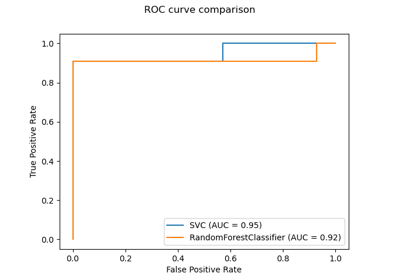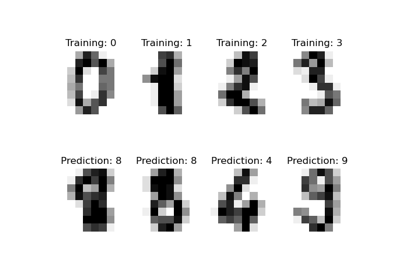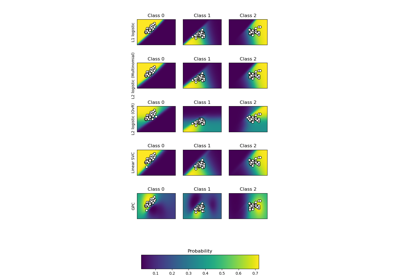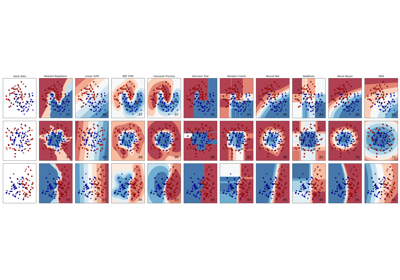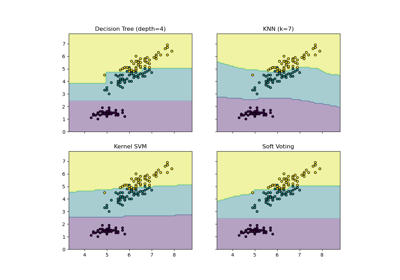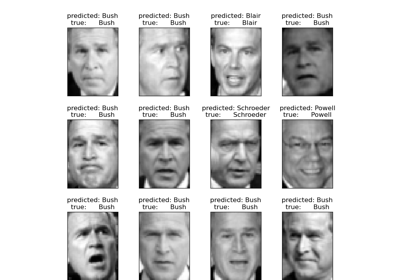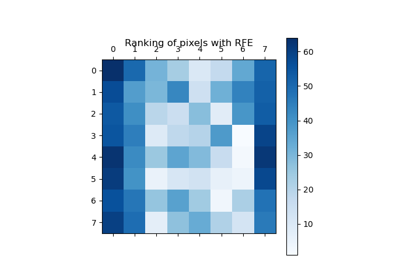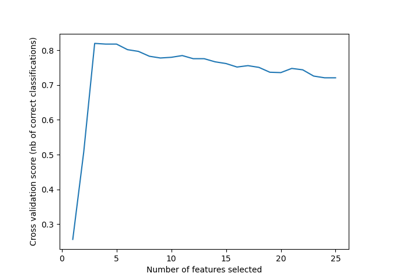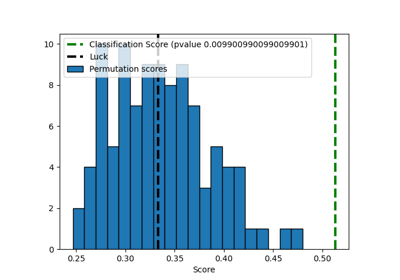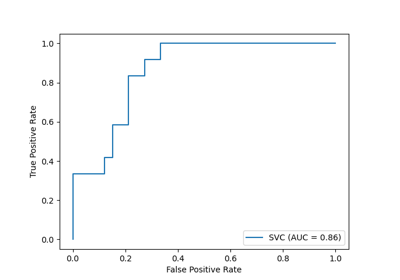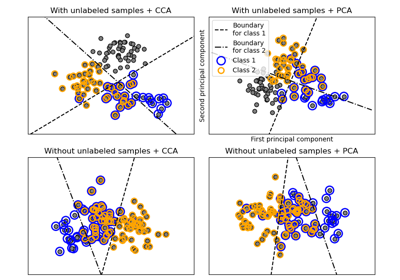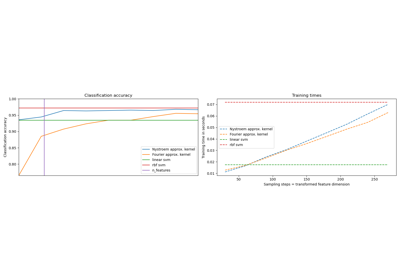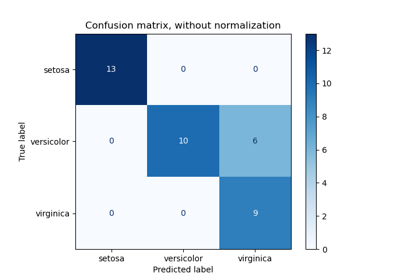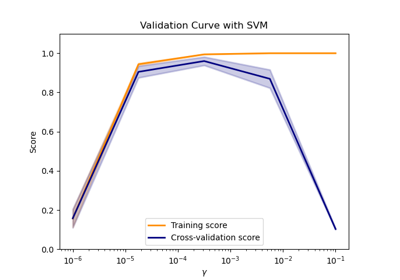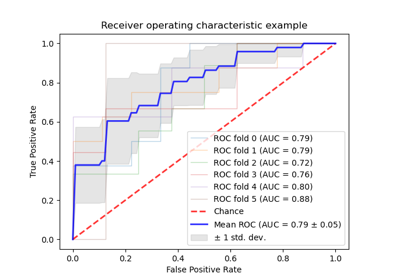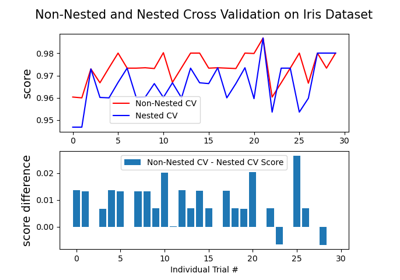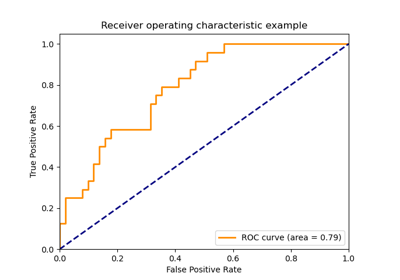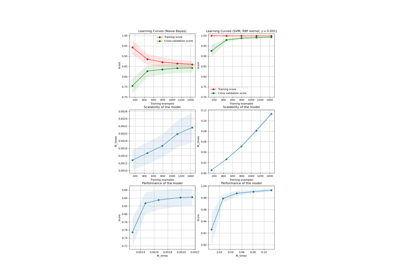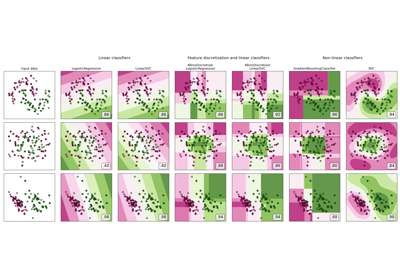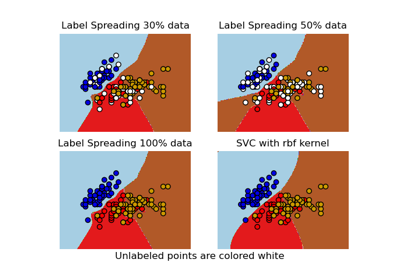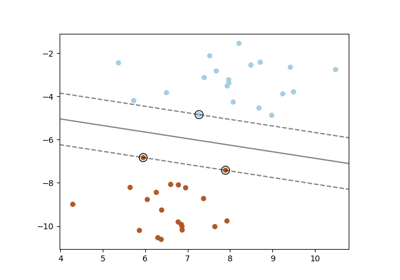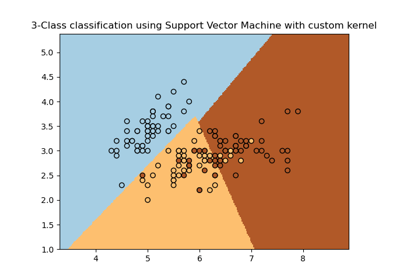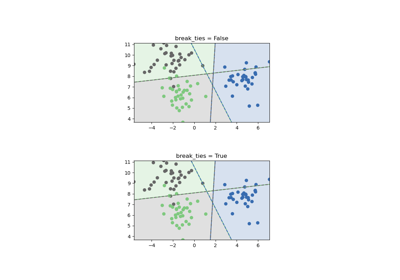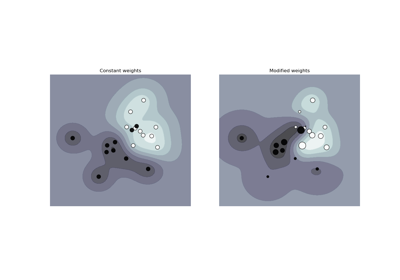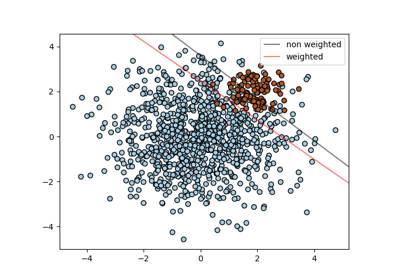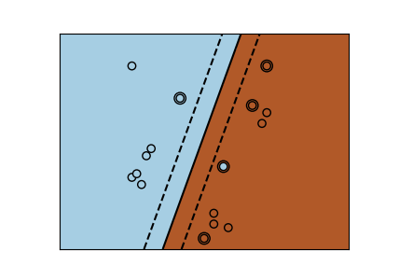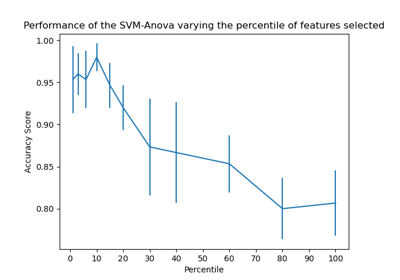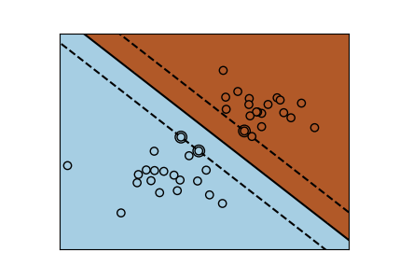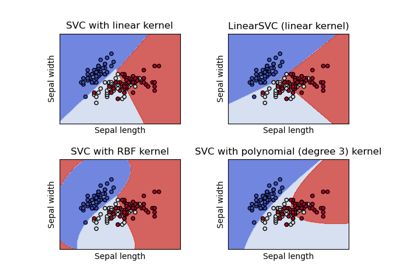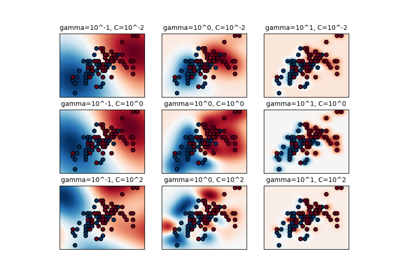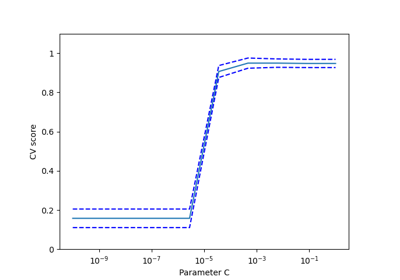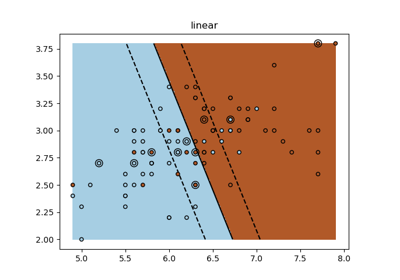sklearn.svm.SVC¶
-
class
sklearn.svm.SVC(*, C=1.0, kernel='rbf', degree=3, gamma='scale', coef0=0.0, shrinking=True, probability=False, tol=0.001, cache_size=200, class_weight=None, verbose=False, max_iter=-1, decision_function_shape='ovr', break_ties=False, random_state=None)[source]¶ C-Support Vector Classification.
The implementation is based on libsvm. The fit time scales at least quadratically with the number of samples and may be impractical beyond tens of thousands of samples. For large datasets consider using
sklearn.svm.LinearSVCorsklearn.linear_model.SGDClassifierinstead, possibly after asklearn.kernel_approximation.Nystroemtransformer.The multiclass support is handled according to a one-vs-one scheme.
For details on the precise mathematical formulation of the provided kernel functions and how
gamma,coef0anddegreeaffect each other, see the corresponding section in the narrative documentation: Kernel functions.Read more in the User Guide.
- Parameters
- Cfloat, default=1.0
Regularization parameter. The strength of the regularization is inversely proportional to C. Must be strictly positive. The penalty is a squared l2 penalty.
- kernel{‘linear’, ‘poly’, ‘rbf’, ‘sigmoid’, ‘precomputed’}, default=’rbf’
Specifies the kernel type to be used in the algorithm. It must be one of ‘linear’, ‘poly’, ‘rbf’, ‘sigmoid’, ‘precomputed’ or a callable. If none is given, ‘rbf’ will be used. If a callable is given it is used to pre-compute the kernel matrix from data matrices; that matrix should be an array of shape
(n_samples, n_samples).- degreeint, default=3
Degree of the polynomial kernel function (‘poly’). Ignored by all other kernels.
- gamma{‘scale’, ‘auto’} or float, default=’scale’
Kernel coefficient for ‘rbf’, ‘poly’ and ‘sigmoid’.
if
gamma='scale'(default) is passed then it uses 1 / (n_features * X.var()) as value of gamma,if ‘auto’, uses 1 / n_features.
Changed in version 0.22: The default value of
gammachanged from ‘auto’ to ‘scale’.- coef0float, default=0.0
Independent term in kernel function. It is only significant in ‘poly’ and ‘sigmoid’.
- shrinkingbool, default=True
Whether to use the shrinking heuristic. See the User Guide.
- probabilitybool, default=False
Whether to enable probability estimates. This must be enabled prior to calling
fit, will slow down that method as it internally uses 5-fold cross-validation, andpredict_probamay be inconsistent withpredict. Read more in the User Guide.- tolfloat, default=1e-3
Tolerance for stopping criterion.
- cache_sizefloat, default=200
Specify the size of the kernel cache (in MB).
- class_weightdict or ‘balanced’, default=None
Set the parameter C of class i to class_weight[i]*C for SVC. If not given, all classes are supposed to have weight one. The “balanced” mode uses the values of y to automatically adjust weights inversely proportional to class frequencies in the input data as
n_samples / (n_classes * np.bincount(y))- verbosebool, default=False
Enable verbose output. Note that this setting takes advantage of a per-process runtime setting in libsvm that, if enabled, may not work properly in a multithreaded context.
- max_iterint, default=-1
Hard limit on iterations within solver, or -1 for no limit.
- decision_function_shape{‘ovo’, ‘ovr’}, default=’ovr’
Whether to return a one-vs-rest (‘ovr’) decision function of shape (n_samples, n_classes) as all other classifiers, or the original one-vs-one (‘ovo’) decision function of libsvm which has shape (n_samples, n_classes * (n_classes - 1) / 2). However, one-vs-one (‘ovo’) is always used as multi-class strategy. The parameter is ignored for binary classification.
Changed in version 0.19: decision_function_shape is ‘ovr’ by default.
New in version 0.17: decision_function_shape=’ovr’ is recommended.
Changed in version 0.17: Deprecated decision_function_shape=’ovo’ and None.
- break_tiesbool, default=False
If true,
decision_function_shape='ovr', and number of classes > 2, predict will break ties according to the confidence values of decision_function; otherwise the first class among the tied classes is returned. Please note that breaking ties comes at a relatively high computational cost compared to a simple predict.New in version 0.22.
- random_stateint or RandomState instance, default=None
Controls the pseudo random number generation for shuffling the data for probability estimates. Ignored when
probabilityis False. Pass an int for reproducible output across multiple function calls. See Glossary.
- Attributes
- support_ndarray of shape (n_SV,)
Indices of support vectors.
- support_vectors_ndarray of shape (n_SV, n_features)
Support vectors.
- n_support_ndarray of shape (n_class,), dtype=int32
Number of support vectors for each class.
- dual_coef_ndarray of shape (n_class-1, n_SV)
Dual coefficients of the support vector in the decision function (see Mathematical formulation), multiplied by their targets. For multiclass, coefficient for all 1-vs-1 classifiers. The layout of the coefficients in the multiclass case is somewhat non-trivial. See the multi-class section of the User Guide for details.
- coef_ndarray of shape (n_class * (n_class-1) / 2, n_features)
Weights assigned to the features (coefficients in the primal problem). This is only available in the case of a linear kernel.
coef_is a readonly property derived fromdual_coef_andsupport_vectors_.- intercept_ndarray of shape (n_class * (n_class-1) / 2,)
Constants in decision function.
- fit_status_int
0 if correctly fitted, 1 otherwise (will raise warning)
- classes_ndarray of shape (n_classes,)
The classes labels.
- probA_ndarray of shape (n_class * (n_class-1) / 2)
- probB_ndarray of shape (n_class * (n_class-1) / 2)
If
probability=True, it corresponds to the parameters learned in Platt scaling to produce probability estimates from decision values. Ifprobability=False, it’s an empty array. Platt scaling uses the logistic function1 / (1 + exp(decision_value * probA_ + probB_))whereprobA_andprobB_are learned from the dataset [2]. For more information on the multiclass case and training procedure see section 8 of [1].- class_weight_ndarray of shape (n_class,)
Multipliers of parameter C for each class. Computed based on the
class_weightparameter.- shape_fit_tuple of int of shape (n_dimensions_of_X,)
Array dimensions of training vector
X.
See also
References
Examples
>>> import numpy as np >>> from sklearn.pipeline import make_pipeline >>> from sklearn.preprocessing import StandardScaler >>> X = np.array([[-1, -1], [-2, -1], [1, 1], [2, 1]]) >>> y = np.array([1, 1, 2, 2]) >>> from sklearn.svm import SVC >>> clf = make_pipeline(StandardScaler(), SVC(gamma='auto')) >>> clf.fit(X, y) Pipeline(steps=[('standardscaler', StandardScaler()), ('svc', SVC(gamma='auto'))])
>>> print(clf.predict([[-0.8, -1]])) [1]
Methods
Evaluates the decision function for the samples in X.
fit(X, y[, sample_weight])Fit the SVM model according to the given training data.
get_params([deep])Get parameters for this estimator.
predict(X)Perform classification on samples in X.
score(X, y[, sample_weight])Return the mean accuracy on the given test data and labels.
set_params(**params)Set the parameters of this estimator.
-
__init__(*, C=1.0, kernel='rbf', degree=3, gamma='scale', coef0=0.0, shrinking=True, probability=False, tol=0.001, cache_size=200, class_weight=None, verbose=False, max_iter=-1, decision_function_shape='ovr', break_ties=False, random_state=None)[source]¶ Initialize self. See help(type(self)) for accurate signature.
-
decision_function(X)[source]¶ Evaluates the decision function for the samples in X.
- Parameters
- Xarray-like of shape (n_samples, n_features)
- Returns
- Xndarray of shape (n_samples, n_classes * (n_classes-1) / 2)
Returns the decision function of the sample for each class in the model. If decision_function_shape=’ovr’, the shape is (n_samples, n_classes).
Notes
If decision_function_shape=’ovo’, the function values are proportional to the distance of the samples X to the separating hyperplane. If the exact distances are required, divide the function values by the norm of the weight vector (
coef_). See also this question for further details. If decision_function_shape=’ovr’, the decision function is a monotonic transformation of ovo decision function.
-
fit(X, y, sample_weight=None)[source]¶ Fit the SVM model according to the given training data.
- Parameters
- X{array-like, sparse matrix} of shape (n_samples, n_features) or (n_samples, n_samples)
Training vectors, where n_samples is the number of samples and n_features is the number of features. For kernel=”precomputed”, the expected shape of X is (n_samples, n_samples).
- yarray-like of shape (n_samples,)
Target values (class labels in classification, real numbers in regression)
- sample_weightarray-like of shape (n_samples,), default=None
Per-sample weights. Rescale C per sample. Higher weights force the classifier to put more emphasis on these points.
- Returns
- selfobject
Notes
If X and y are not C-ordered and contiguous arrays of np.float64 and X is not a scipy.sparse.csr_matrix, X and/or y may be copied.
If X is a dense array, then the other methods will not support sparse matrices as input.
-
get_params(deep=True)[source]¶ Get parameters for this estimator.
- Parameters
- deepbool, default=True
If True, will return the parameters for this estimator and contained subobjects that are estimators.
- Returns
- paramsmapping of string to any
Parameter names mapped to their values.
-
predict(X)[source]¶ Perform classification on samples in X.
For an one-class model, +1 or -1 is returned.
- Parameters
- X{array-like, sparse matrix} of shape (n_samples, n_features) or (n_samples_test, n_samples_train)
For kernel=”precomputed”, the expected shape of X is (n_samples_test, n_samples_train).
- Returns
- y_predndarray of shape (n_samples,)
Class labels for samples in X.
-
property
predict_log_proba¶ Compute log probabilities of possible outcomes for samples in X.
The model need to have probability information computed at training time: fit with attribute
probabilityset to True.- Parameters
- Xarray-like of shape (n_samples, n_features) or (n_samples_test, n_samples_train)
For kernel=”precomputed”, the expected shape of X is (n_samples_test, n_samples_train).
- Returns
- Tndarray of shape (n_samples, n_classes)
Returns the log-probabilities of the sample for each class in the model. The columns correspond to the classes in sorted order, as they appear in the attribute classes_.
Notes
The probability model is created using cross validation, so the results can be slightly different than those obtained by predict. Also, it will produce meaningless results on very small datasets.
-
property
predict_proba¶ Compute probabilities of possible outcomes for samples in X.
The model need to have probability information computed at training time: fit with attribute
probabilityset to True.- Parameters
- Xarray-like of shape (n_samples, n_features)
For kernel=”precomputed”, the expected shape of X is [n_samples_test, n_samples_train]
- Returns
- Tndarray of shape (n_samples, n_classes)
Returns the probability of the sample for each class in the model. The columns correspond to the classes in sorted order, as they appear in the attribute classes_.
Notes
The probability model is created using cross validation, so the results can be slightly different than those obtained by predict. Also, it will produce meaningless results on very small datasets.
-
score(X, y, sample_weight=None)[source]¶ Return the mean accuracy on the given test data and labels.
In multi-label classification, this is the subset accuracy which is a harsh metric since you require for each sample that each label set be correctly predicted.
- Parameters
- Xarray-like of shape (n_samples, n_features)
Test samples.
- yarray-like of shape (n_samples,) or (n_samples, n_outputs)
True labels for X.
- sample_weightarray-like of shape (n_samples,), default=None
Sample weights.
- Returns
- scorefloat
Mean accuracy of self.predict(X) wrt. y.
-
set_params(**params)[source]¶ Set the parameters of this estimator.
The method works on simple estimators as well as on nested objects (such as pipelines). The latter have parameters of the form
<component>__<parameter>so that it’s possible to update each component of a nested object.- Parameters
- **paramsdict
Estimator parameters.
- Returns
- selfobject
Estimator instance.

